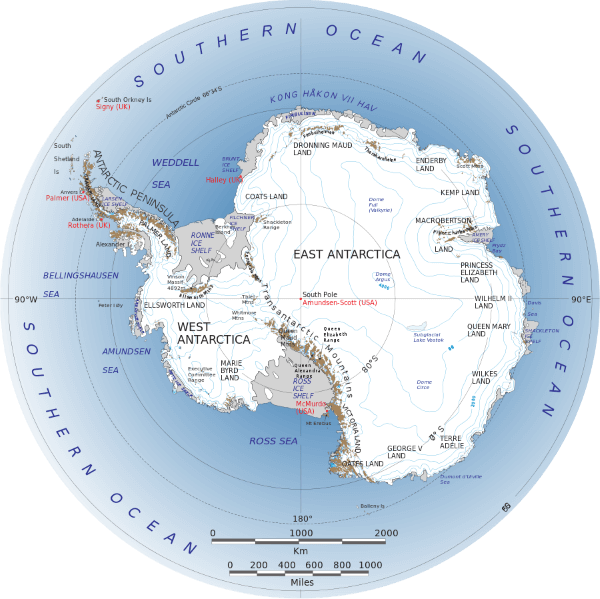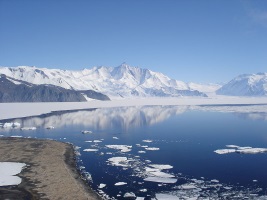Antarctica -- School-age
Antarctica- The Frozen Continent at the South Pole
Things to Know
Antarctica the continect surrounding the South Pole is the fifth largest continent. It is the coldest, windiest, and driest continent on Earth. On this continent no people live. Groups of scientists come for periods of time to study this frigid land. Many countries operate science stations in Antarctica, but no nation owns the land.
Animals
Antarctica has a lot of animals in the sea -- whales, fish, krill (small crustaceans like prawns), seals. The only land animals in Antarctica are penguins and seals (and people). Animals of Antarctica at National Geographic.
Krill are an important food source. Most of the animal species in the Antarctic eat krill. Antarctic penguins main food source is krill.
Antarctic Krill
Antarctica Wildlife - British Antarctic
Huskies were first used in the Antarctic by the British Antarctic Expedition of 1898-1900.
Explorers
The Ancient Greeks speculated that land lay south of the known world, attempts to find it were defeated by the ice.
The first proof was found during the second voyage (1772–75) of the English explorer Captain James Cook. His expedition was the first to cross the Arntarctic Circle. They did not see land, but they saw rocks in some of the icebergs, which meant there must be land. After Captain James Cook other explorers ventured into the Antarctic Circle.
Schackleton and The Nimrod Expedition: 1907-09 - For 100 years James Weddell held the record for sailing the furthest south.
Captain Robert F. Scott
Follows in the footsteps of Captain Scott.
Captain James Cook - a British explorer and astronomer who went on many expeditions to the Pacific Ocean, Antarctic, Arctic, and around the world.
James Clark Ross entered the Navy at 11 years of age and he discovered the North Magnetic Pole.
Roald Amundsen - first to the South Pole
Richard E. Byrd lead eleven expeditions to the Antarctic.
Operation Highjump - U.S. Navy Antarctic Developments Project, 1946-1947.
Operation Windmill - U.S. Navy Second Antarctic Developments Project,1947-48.
Video
Endurance Ship Found
The Endurance, the ship of legendary Antarctic explorer Ernest Shackleton went down in the Weddell Sea in 1915.
In March 2022 Sir Ernest Shackleton's Endurance was found.
Antarctic explorer Ernest Shackleton’s lost ship Endurance found after 107 years
The British-led Endurance22 Expedition found the vessel.
Royal Geographical Society-Exploring Shackleton's Anartica for schools.
Fascinating imagery Lesson
Explore the work of Frank Hurley the expedition photographer tasked with documenting the expedition.
Sir Ernest Shackleton’s HMS Endurance Found Video
Recommended Books
Antarctica

Climate
The seasons in Antarctica are the opposite of the seasons in the Northern hemispheresummer is October through February. Winter is March through September. The sun sets in March and rises in October. For six months of the year, there are 24 hours of sunshine each day.
Antarctica is the coldest continent. Antarctica is technically the world's largest desert. It averages less than 4 mm of precipitation monthly, about the same as the Sahara Desert. The reason that there is so much snow in Antarctica is that the stuff never melts!
Land
The largest glacier in the world is the Lambert-Fisher Glacier in Antarctica. At 400 kilometers (250 miles) long, and up to 100 kilometers (60 miles) wide.
Plants
Only about two percent of Antarctica is free of ice, severely limiting the places where plants may grow. There are no trees or shrubs. The flora of Antarctica is made up of lichen species, moss (most found only on the Antarctic Peninsula), non-marine algae, and a larger number of fungi and bacteria. Plants of Antarctica
In the snow and surface ice snow algae may be found coloring the snow red, green, yellow or gray in summer.
Video
Southern Ocean
The Earth's oceans although distinct are all connected to one another.
Until the year 2000, there were four recognized oceans: the Pacific, Atlantic, Indian, and Arctic. In the Spring of 2000, the International Hydrographic Organization delimited (having fixed boundaries or limits) a new ocean, The Southern Ocean.
The Southern Ocean surrounds Antarctica and extends to 60 degrees latitude; and connects the Atlantic, Pacific, and Indian Oceans and is the world's fourth largest ocean.
Video
Recommended Book
Tacky the Penguin by by Helen Lester
Tacky's friends find him annoying until his eccentric behavior saves the day.
Story
Things to Do
Sites to See
View
Satellite
View
View from 9100 km above the Earth.
Rarely Seen "Southern Lights" over Amundsen-Scott South Pole Station
NOVA: Mountain of Ice
Panoramic views of the landscape from the trek to Vinson Massif, follow the life cycle of a glacier, and more.
Video









